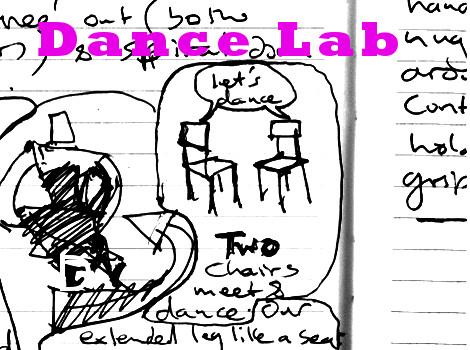The publicity for this session at Oxford Contact Dance read: Falling in love might be easy but falling in dance can be trickier! In this ‘laboratory’ session, we’ll investigate falling which is fun, safe and dynamic using techniques from contact improvisation. Let’s lab!
There were four of us at this Lab session which was perfect. The idea of the lab is that participants research, investigate and discover ways of moving which is then feedback to the others: two people sit out and watch while the other two investigate. We swap roles and repeat: it’s iterative.
We had a warm-up – lying on the floor and allowing our pelvis to roll and fall; using our hands on the floor to assist; from sitting – using akido rolling around on our arms and shoulders – a moving point of contact; and small falls from sitting – catching with our hands and shoulders. A gentle start. We tried some sliding on the floor. Initially from sitting and then from standing where you drop onto your hands and slide.
Spiralling
Firstly, we investigated a simple fall – infact, it was taught at one of my first classes for contact improvisation. One partner lies on the floor – semi-reclined. The other is standing beside them and facing them. The lying person pulls the right knee from behind and then pushes on the left hip. The standing person falls – spiralling – and into the lap or centre of the lying person. How does this make the falling movement more comfortable? Firstly, the descent gradient is reduced by the spiral i.e. the pathway lengthens and the rate of descent decreases. Secondly, the fall is broken or mitigated by the body of the lying person. It’s the ‘air bag’ approach!!
We ‘lab’ the simple fall by starting the rotation in the opposite direction – reverse the pulling and pushing. We also pull the supporting leg away by using our legs rather than hands, and we try catching on our back while in table rather than lying on our back face-up.
The other ways of falling which we researched (in our pairs) were:
Counter balancing
This is simple: stand opposite your partner and link hands; lean back. It’s counter balancing / counter weighting We can adjust our feet, crossing into the space of our partner for example. We can also hold onto other parts of the body – for example: both partners holding the head of each other as the anchor point rather than linking hands.
Chair!
Another discovery which we had, was that we could stand, lean back and use our hips as the anchor point. In this case then the chest and upper bodies of the partners are press together and embraced. There’s not a lot of counter-balance and the result is a person with four legs! We can also offer our foreleg to support our partner by opening our leg out. Thus our partner ‘sits’ on it rather like a chair: two chairs as there’s two people offering. It’s two chairs dancing perhaps? Indeed, the partners can recline and their back is fully supported by the out-stretched leg of their partner. It reminded me our a bench chair which you sometimes see in cafes.
Elastic structures
Often we have a situation in contact improvisation where one partner is lying on their back on the floor and the other is standing. There are lots of ways that we can support our partner in this way, for example the lying person becomes a base and the standing person a flyer. The feet of the lying person are offered to the hips of the standing person and can push-back our partner as they fall forward. (This video of Maga Radlowska and Marty Dzian is a nice example).
Our lab’ing was mostly concerned with a more compact base. Initially, we started with one person lying on their back with their legs drawn to their belly. Thus our shins are offered as a points of contact. Our partner can then lie face down on the shins and give their weight. We could also use this structure in a dynamic way as the shins and body act as a spring: they can compressed with our partner’s weight and then released returning the force. Thus you can fall onto it and it pushes you out or it simply allows you to roll off it after accepting the falling body. Strangely, the base looks like an ‘upside down’ table position or insect on their back with legs in the air!
A simple way into or onto the shins, is to use the ‘serve’ familiar from body surfing. One partner sits on the floor with their back to their partner. Sitting behind the back of their partner, the shin folded back are bought into contact with the back. The sitting can lean back (fall back) and give their weight; as they do this then they rotate their upper body onto the side and they are transported over their partner who is lying on their back.
In this video below, Andy Solway (under-dancer/base) and Piotr Znamierowski (over-dancer/flyer) show one of their discoveries at the Dance Lab session. Flying a person upside down and on your shins.
